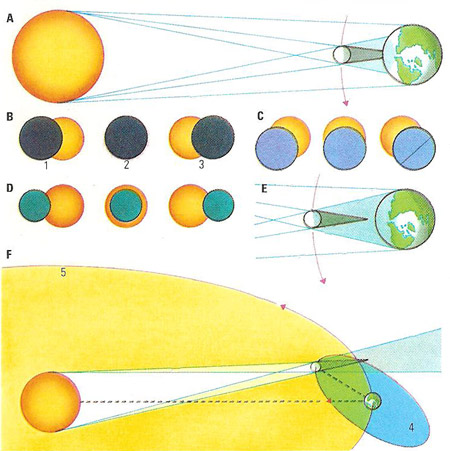eclipse

In a total solar eclipse (A) the main cone of shadow or umbra reaches the Earth's surface while to either side of it, in the partial shadow or penumbra, a partial eclipse is seen. The Moon and Sun (B) approach totality (1), arrive at totality (2), and leave totality (3). C shows a partial eclipse that is not total anywhere on Earth. An annular eclipse (D) occurs when the umbra stops short of Earth. F shows how the tilt of the Moon's (4) to the plane of Earth's orbit (5) prevents an eclipse from occurring every month of the year.
An eclipse is the total or partial concealment of one celestial body by another, a phenomenon
seen in solar eclipses, lunar
eclipses, and eclipsing binary stars.
A solar eclipse happens when the Moon passes between Earth and the Sun so that the Sun's like is blocked from the part of Earth on which the Moon's shadow, or umbra,
falls. A lunar eclipse is caused by Earth when it moves
between the Sun and the Moon so that the Moon passes into Earth's umbra,
and cannot shine by reflected sunlight. Both kinds of eclipses can be total,
when Earth or the Moon pass completely into the other's umbra; or partial,
when Earth or the Moon remain partly in the other's partial shadow,
or penumbra.
If a solar eclipse happens when the Moon is at apogee (furthest point from Earth), its apparent size is less than the Sun's, and an annular, or ring, eclipse results, with the Sun appearing as a bright ring around the dark Moon. If the Earth and the Moon's orbits were in the same plane, solar and lunar eclipses would be monthly, occurring at new and full moons. But because the Moon's orbit is at an angle to Earth's, eclipses are possible only when the Moon crosses Earth's orbital plane and is in line with Earth and the Sun. These conditions happen seven times a year at the most.
An eclipse season is a period in a given year during which the Earth-Sun line falls near the line of nodes of the Moon's orbit, so that lunar and solar eclipses can take place. Eclipse seasons recur every 173.31 days and last about 24 days for lunar eclipses and about 37 days for solar eclipses. Two eclipse seasons make one eclipse year.
To early people's eclipses, especially of the Sun, were awe-inspiring events. It isn't surprising that the knowledge that eclipses can be predicted added greatly to the authority of its discoverers, the astronomer-priests of Chaldea (Mesopotamia). Today solar eclipses enable astronomers to make studies that are not normally possible, such as checking Einstein's theory of relativity.
Compare with occultation and transit.


